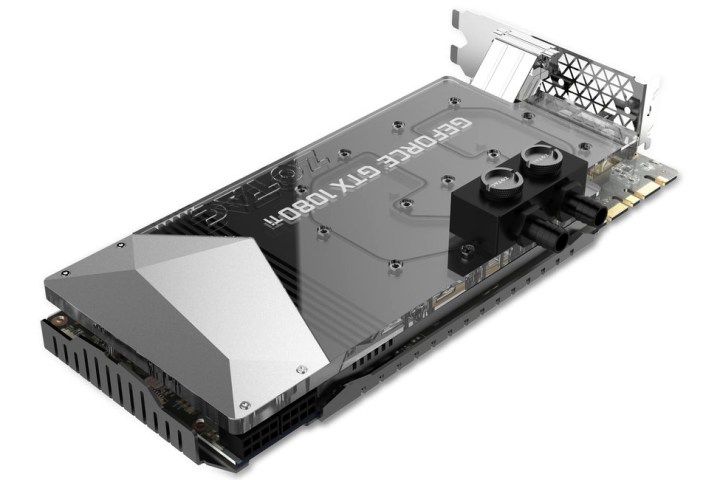
Here are the specs compared to Nvidia’s reference GTX 1080 TI design:
| GTX 1080 TI ArcticStorm | GTX 1080 Ti Reference | |
| Graphics chip: | GP102-350 | GP102-350 |
| Architecture: | Pascal | Pascal |
| CUDA cores: | 3,584 | 3,584 |
| Base speed: | 1,506MHz | 1,480MHz |
| Boost speed: | 1,620MHz | 1,582MHz |
| Memory amount: | 11GB GDDR5X | 11GB GDDR5X |
| Memory bus: | 352-bit | 352-bit |
| Memory clock: | 11Gbps | 11Gbps |
| Ports: | 3x DisplayPort 1.4 1X HDMI 2.0b 1x DL-DVI-D |
1x DisplayPort 1.4 1x HDMI 2.0b |
| Power consumption: | 270 watts | 250 watts |
| Recommended power: | 600 watts | 600 watts |
| Power connection: | 2x 8-pin | 1x 6-pin, 1x 8-pin |
| Slot size: | 2 slots | 2 slots |
| Dimensions (inches): | 11.81 (L) x 5.83 (H) x 1.71 (W) | 10.5 (L) x 4.376 (H) x 1.71 (W) |
| Price: | $780(?) | $700 |
As the specs show, the card is clocked slightly higher than Nvidia’s reference GTX 1080 TI design in both the base and boost speeds. This overclocking is kept under wraps due to the on-board liquid cooling support, thus customers will want to turn to the fan-based GTX 1080 Ti AMP Extreme models if they want an overclocked card but don’t have a liquid cooling system in their PC.
In addition to the liquid cooling feature, Zotac’s new card includes the company’s Spectra LED-based lighting system that’s customizable through the free (and redesigned) FireStorm software. This LED system is complemented by a wraparound backplate to spruce up the card’s visuals as its seated in the PC’s PCI Express 3.0 slot.
Zotac’s new GTX 1080 Ti supports a 16 + 2 power phase to stabilize the overclocking, meaning 16 power phases are dedicated solely to the GP102-350 chip for clean, steady voltage. In other words, when voltage is received by the PC’s power supply, it’s received by 16 transistors and two switches each, which supposedly prevents voltage drops and reduces heat.
Adding to that, the new Zotac card features the company’s Power Boost technology. “Doubling up to reduce ripple noise and minimize power fluctuation to enable a longer lasting amped graphics card even when pushed to the limit,” the product page states.
In the box, the card ships with two dual-mesh-wrapped 6-pin to 8-pin power cables, and two G1/4-thread 0.375-inch fittings. When the card ships and for how much is unknown, as it wasn’t listed on Newegg or Amazon at the time this article went live. However, Zotac’s previous GTX 1080 ArticStorm sells for $634 while Nvidia sells its base model for $550. Thus, if Nvidia is selling the GTX 1080 Ti for $700, expect Zotac’s solution to possibly sell for around $780.


